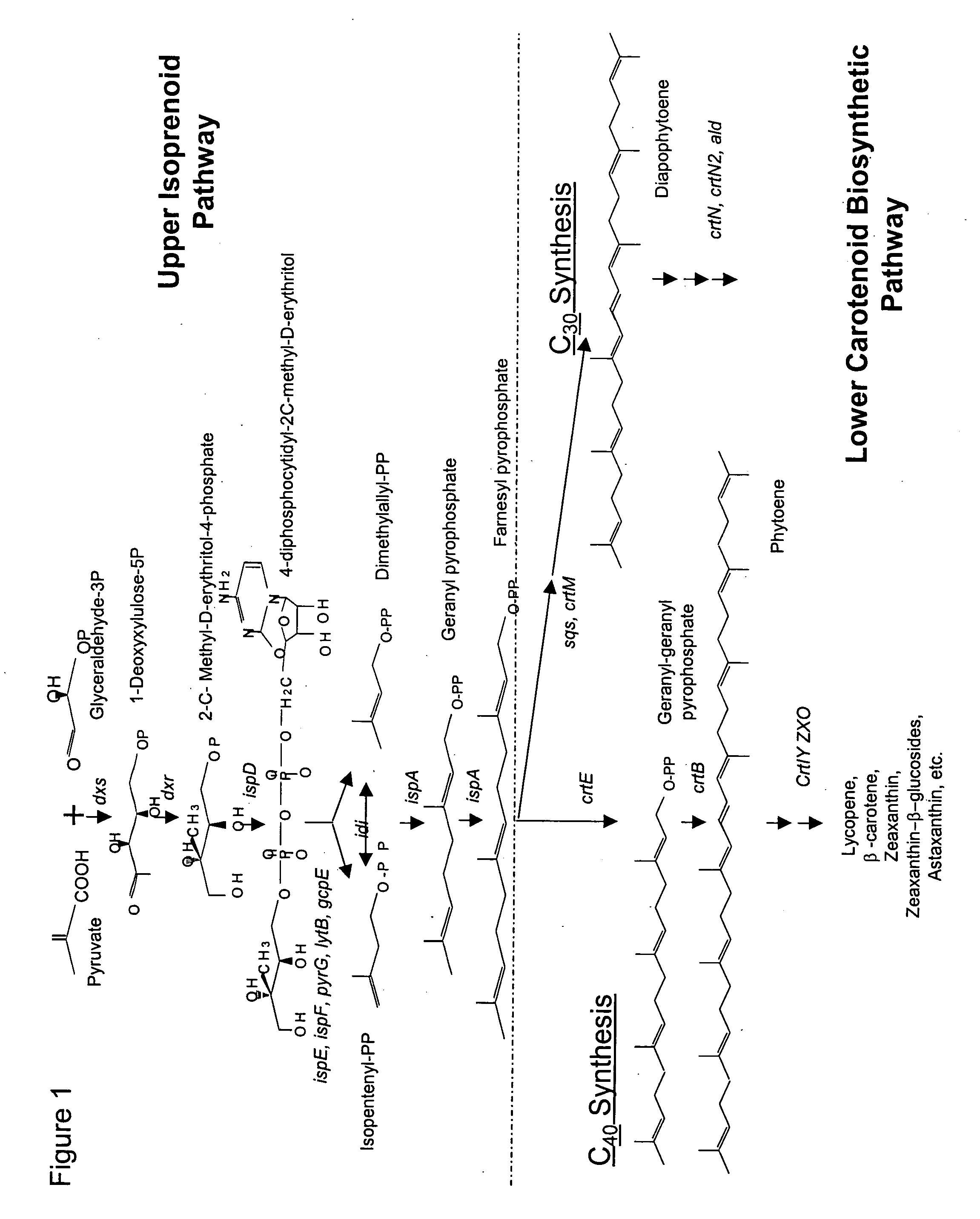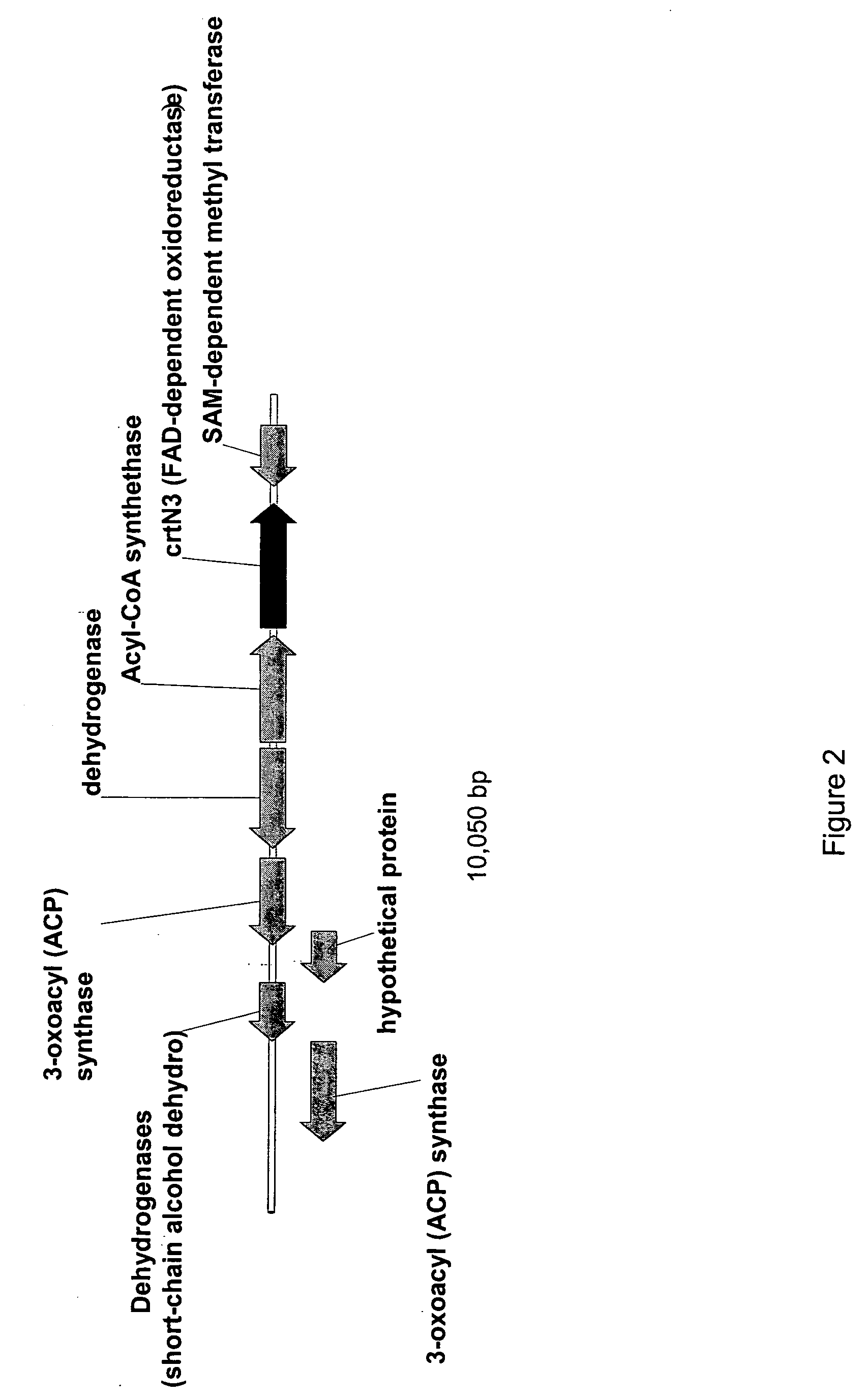Optimized bacterial host strains of methylomonas sp. 16a
a technology of methylomonas sp. 16a and host strain, applied in the field of microbiology and molecular biology, can solve the problems of low product yield, low product yield, and inability to economically succeed scp so far, and achieve the effect of increasing the production of downstream carotenoids and effective use of carbon for carotenoid production
- Summary
- Abstract
- Description
- Claims
- Application Information
AI Technical Summary
Benefits of technology
Problems solved by technology
Method used
Image
Examples
example 1
Growth of Methylomonas sp. 16a
Example 1 summarizes the standard conditions used for growth of Methylomonas sp. 16a (ATCC# PTA-240), as described in U.S. Pat. No. 6,689,601; hereby incorporated by reference.
Methylomonas Strain and Culture Media
[0236] The growth conditions described below were used throughout the following experimental Examples for treatment of Methylomonas 16a, unless conditions were specifically described otherwise.
[0237]Methylomonas sp. 16a was typically grown in serum stoppered Wheaton bottles (Wheaton Scientific; Wheaton, Ill.) using a gas / liquid ratio of at least 8:1 (i.e., 20 mL of ammonium liquid “BTZ” growth medium in a Wheaton bottle of 160 mL total volume). The composition of the BTZ growth medium is given below. The standard gas phase for cultivation contained 25% methane in air, although methane concentrations can vary ranging from about 5-50% by volume of the culture headspace. These conditions comprise growth conditions and the cells are referred to...
example 2
Construction of a Positive-Selection Suicide Vector for Methylomonas sp. Strain 16a
[0240] The construction of chromosomal mutations within the Methylomonas genome required the use of suicide vectors. Thus, a modified version of the conditional replication vector pGP704 was created, comprising a npr-sacB cassette.
pGP704 as a Vector Backbone for the C1 Chromosomal Integration Vector
[0241] The plasmid pGP704 (Miller and Mekalanos, J. Bacterol., (170): 2575-2583 (1988); FIG. 5) was chosen as a suitable vector backbone for the C1 chromosomal integration vector, since it could be used as a vehicle to transfer replacement nucleotide sequences of interest into Methylomonas sp. 16a via conjugation. Plasmid pGP704 is a derivative of pBR322 that is AmpR but has a deletion of the pBR322 origin of replication (oriE1). Instead, the plasmid contains a cloned fragment containing the origin of replication of plasmid R6K. The R6K origin of replication (oriR6K) requires the Π protein, encoded by t...
example 3
Construction of pGP704::sacB::ΔCarotenoid Gene of Interest
[0254] The present Example describes the creation of crt integration vectors that enable production of deletions within the native C30 biosynthetic pathway of the Methylomonas genome. Specifically, 5 constructs were made based on the positive selection vector pGP704::sacB that enable chromosomal deletions within the crtN1, crtN1 / ald, crtN2 and crtN3 genes; additionally, since the crtN1, ald, crtN2 genes (crt cluster) exist in an operon and these genes are co-transcribed from the same promoter, an additional construct was created that would permit deletion of the promoter for the crt cluster. These constructs (i.e., pGP704::sacB::ΔcrtN1, pGP704::sacB::Δald(crtN1), pGP704::sacB::Δald, pGP704::sacB::ΔcrtN2, pGP704::sacB::ΔcrtN3, and pGP704::sacB::Δ promoter crt cluster, pGP704::sacB::Δ crt cluster) were generated using standard PCR and cloning methods, as described below.
PCR Amplification and Cloning of the Carotenoid Deletio...
PUM
| Property | Measurement | Unit |
|---|---|---|
| total volume | aaaaa | aaaaa |
| total volume | aaaaa | aaaaa |
| volume | aaaaa | aaaaa |
Abstract
Description
Claims
Application Information
 Login to View More
Login to View More - R&D
- Intellectual Property
- Life Sciences
- Materials
- Tech Scout
- Unparalleled Data Quality
- Higher Quality Content
- 60% Fewer Hallucinations
Browse by: Latest US Patents, China's latest patents, Technical Efficacy Thesaurus, Application Domain, Technology Topic, Popular Technical Reports.
© 2025 PatSnap. All rights reserved.Legal|Privacy policy|Modern Slavery Act Transparency Statement|Sitemap|About US| Contact US: help@patsnap.com



